Note
Go to the end to download the full example code.
1. Making your first figure
This tutorial covers the basics of creating a figure using PyGMT - a
Python wrapper for the Generic Mapping Tools (GMT). It will only use
the pygmt.Figure.coast method for plotting. Later tutorials will
address other PyGMT methods.
Loading the library
The first step is to import pygmt. All methods and figure generation
are accessible from the pygmt top level package.
import pygmt
Creating a figure
All figure generation in PyGMT is handled by the pygmt.Figure class.
Start a new figure by creating an instance of this class:
fig = pygmt.Figure()
To add elements to the figure instance or object (fig in this example)
different methods can be called on it. This example will use the
pygmt.Figure.coast method, which can be used to create a map without
any other methods or external data. The pygmt.Figure.coast
method plots the coastlines, borders, and bodies of water using a database
that is included in GMT.
First, a region for the figure must be selected. This example will plot some
of the coast of Maine in the northeastern US. A Python list can be passed to
the region parameter with the minimum and maximum X-values (longitude)
and the minimum and maximum Y-values (latitude). For this example, the
minimum (bottom left) coordinates are (N43.75, W69) and the maximum (top
right) coordinates are (N44.75, W68). Negative values can be passed for
latitudes in the southern hemisphere or longitudes in the western hemisphere.
In addition to the region, an argument needs to be passed to
pygmt.Figure.coast to tell it what to plot. In this example,
pygmt.Figure.coast will be told to plot the shorelines by passing the
Boolean value True to the shorelines parameter. The shorelines
parameter has other options for finer control, but setting it to True
uses the default values.
fig.coast(region=[-69, -68, 43.75, 44.75], shorelines=True)
To see the figure, call pygmt.Figure.show.
fig.show()
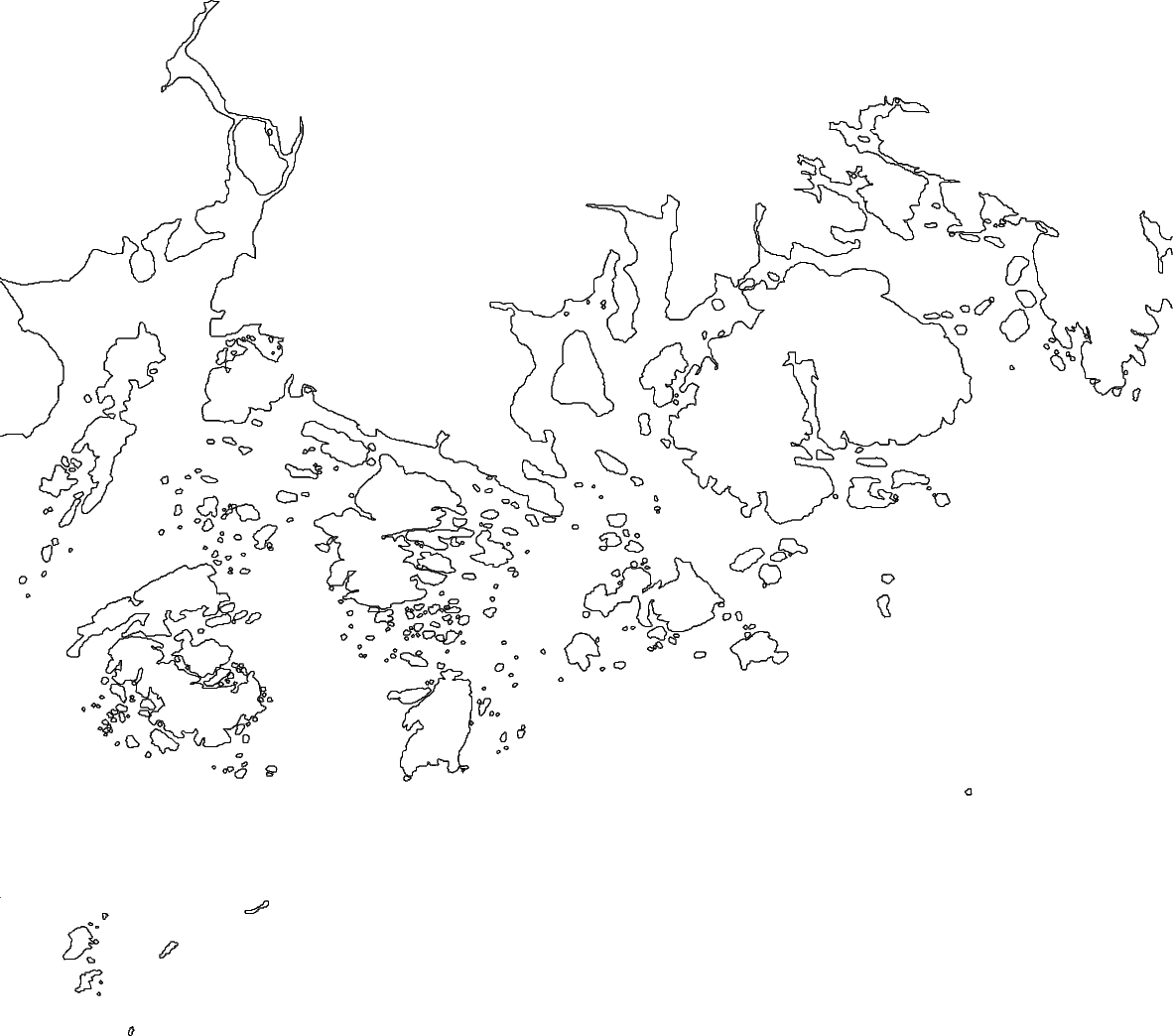
Color the land and water
This figure plots all of the coastlines in the given region, but it does not
indicate where the land and water are. Color values can be passed to land
and water to set the colors on the figure.
When plotting colors in PyGMT, there are multiple
color codes, that can be used. This includes
standard GMT color names (like "skyblue"), R/G/B levels (like
"0/0/255"), a hex value (like "#333333"), or a gray level (like
"gray50"). For this example, GMT color names are used.
fig = pygmt.Figure()
fig.coast(
region=[-69, -68, 43.75, 44.75],
shorelines=True,
land="lightgreen",
water="lightblue",
)
fig.show()
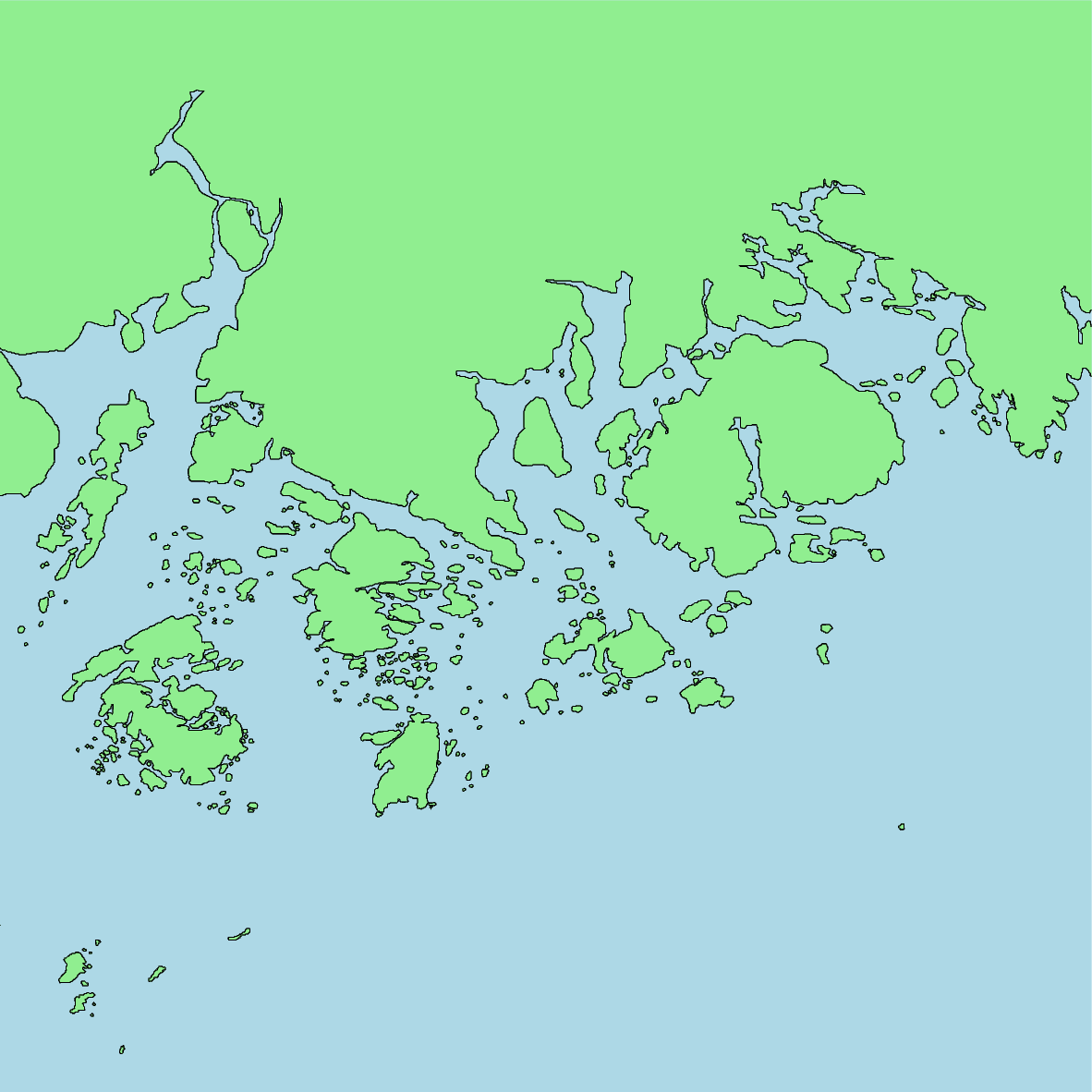
Set the projection
This figure now has its colors set. By default the projection and size
of the map is set to "Q15c+du". Here, "Q" defines a
cylindrical equidistant map projection, "15c+du" means setting
the maximum (upper) map dimension to 15 cm. However, both of
these values can be customized according to the requirements using
the projection parameter.
The appropriate projection varies for the type of map. The available
projections are explained in the projection
gallery. For this example, the Mercator projection is set using "M".
The width of the figure will be 10 centimeters, as set by "10c".
The map size can also be set in inches using “i” (e.g. a 5-inch wide
Mercator projection would use "M5i").
fig = pygmt.Figure()
fig.coast(
region=[-69, -68, 43.75, 44.75],
shorelines=True,
land="lightgreen",
water="lightblue",
projection="M10c",
)
fig.show()
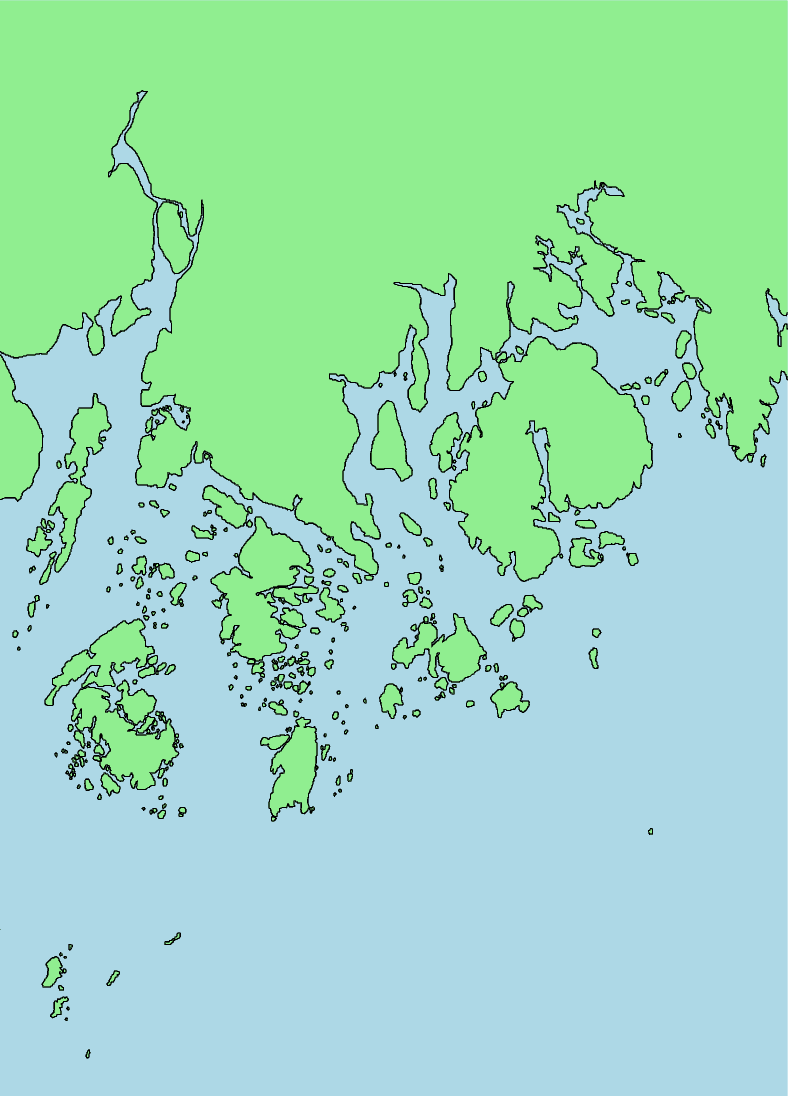
Add a frame
While the map’s colors, projection, and size have been set, the region that is being displayed is not apparent. A frame can be added to annotate the latitude and longitude of the region.
The frame parameter is used to add a frame to the figure. For now, it
will be set to "a" to annotate the axes automatically.
fig = pygmt.Figure()
fig.coast(
region=[-69, -68, 43.75, 44.75],
shorelines=True,
land="lightgreen",
water="lightblue",
projection="M10c",
frame="a",
)
fig.show()
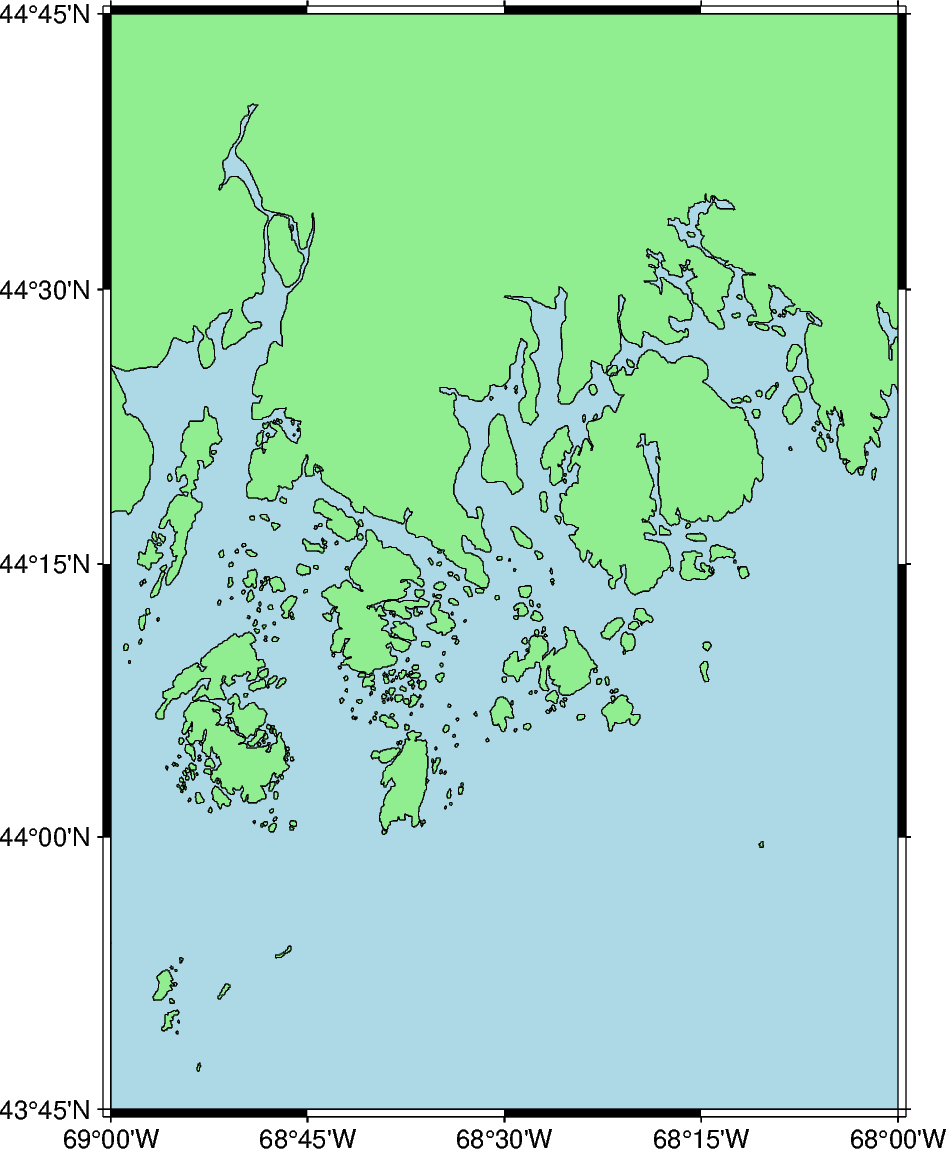
Add a title
The frame parameter can be used to add a title to the figure. The title
is set by passing "+t" followed by the title (e.g. setting the map
title to “Title” would be "+tTitle").
To pass multiple arguments to frame, a list can be used, as shown in the
example below. This format uses frame to set both the axes annotations
and the figure title.
fig = pygmt.Figure()
fig.coast(
region=[-69, -68, 43.75, 44.75],
shorelines=True,
land="lightgreen",
water="lightblue",
projection="M10c",
frame=["a", "+tMaine"],
)
fig.show()
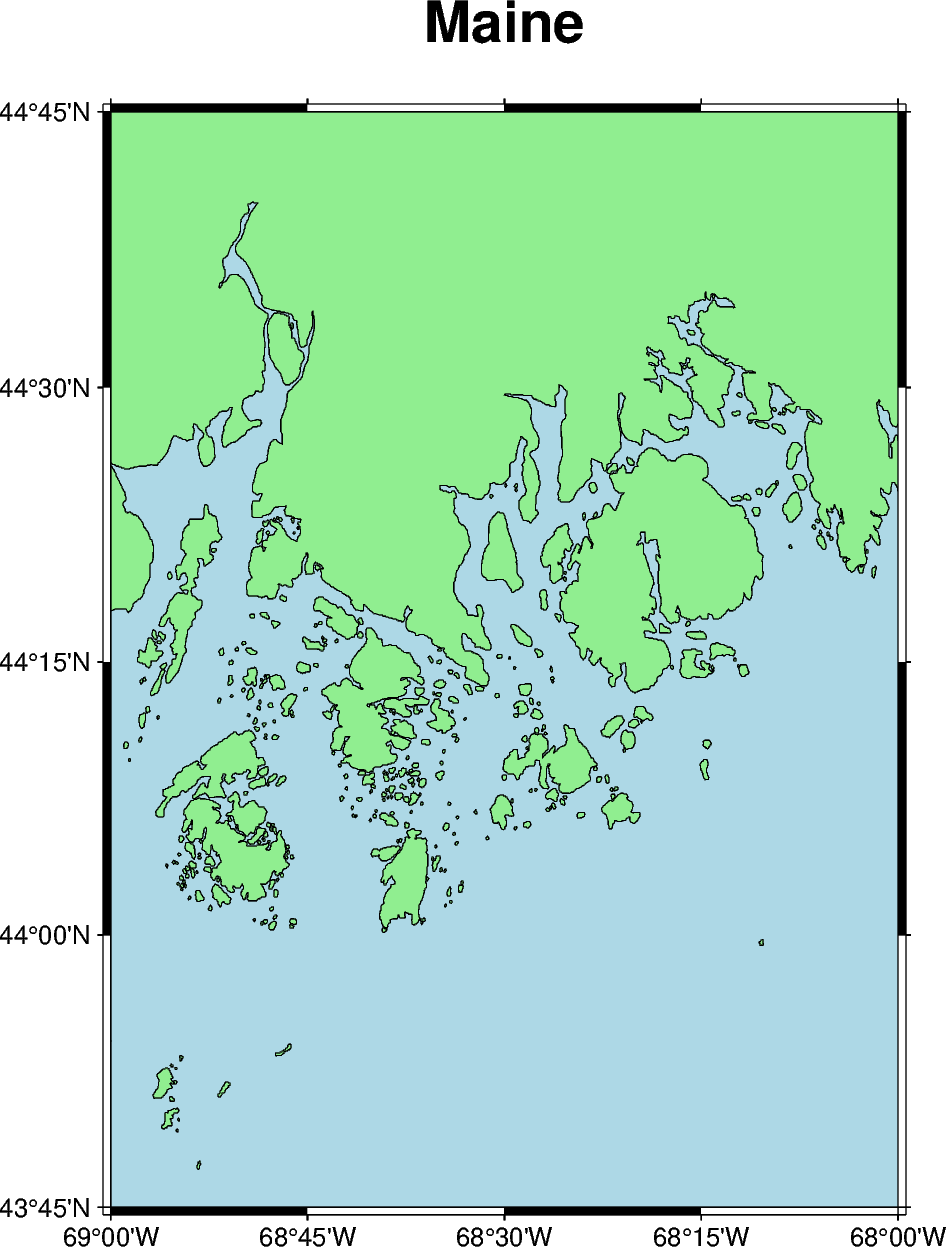
Additional exercises
This is the end of the first tutorial. Here are some additional exercises for the concepts that were discussed:
Make a map of Germany using its ISO country code (“DE”). Pass the ISO code as a Python string to the
regionparameter.Change the color of the landmass to “khaki” and the water to “azure”.
Change the color of the lakes (using the
lakesparameter) to “red”.Create a global map. Set the region to “d” to center the map at the Prime Meridian or “g” to center the map at the International Date Line. When the region is set without using a list full of integers or floating numbers, the argument needs to be passed as a Python string. Create a map with a width of 15 centimeters using the Mollweide (“W”) projection.
Total running time of the script: (0 minutes 1.031 seconds)